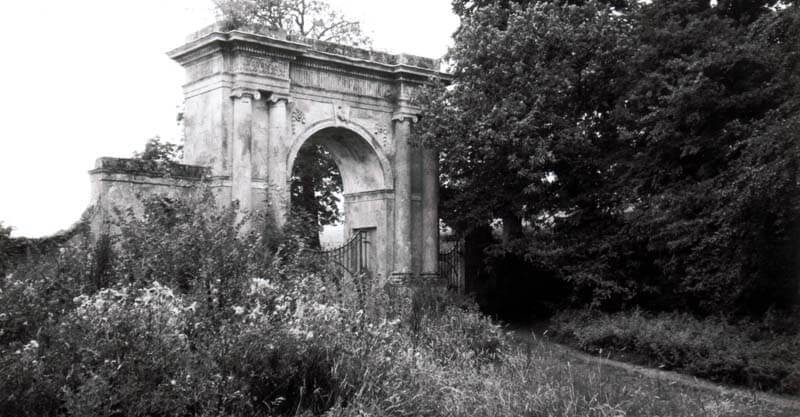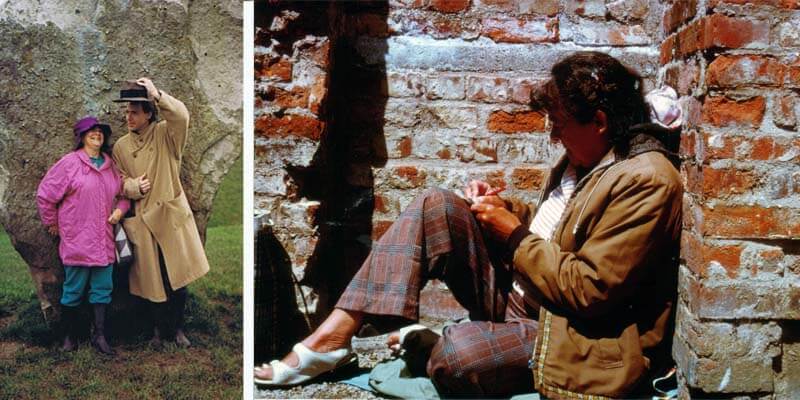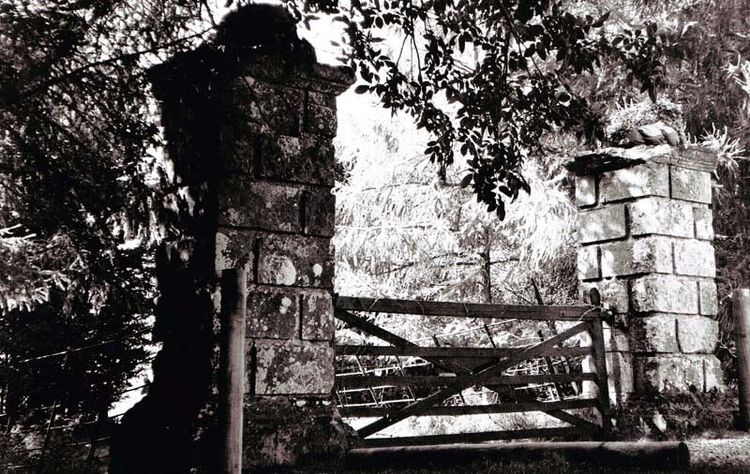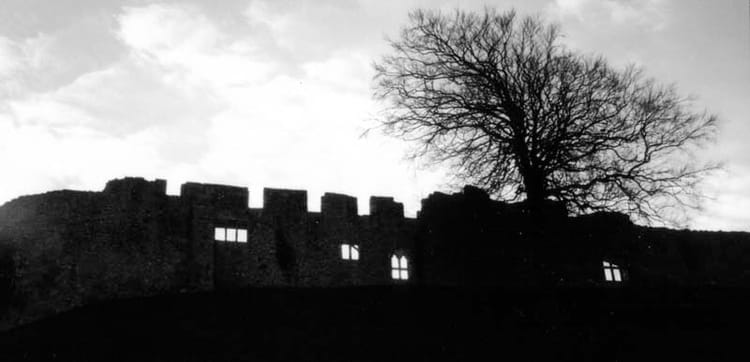Appuldurcombe House. Ghosts of the Isle of Wight, with Margo Williams.

The Freemantle Gate Ghost
APPULDURCOMBE HOUSE is a must-visit on the mystery tour of the Isle of Wight, a genuinely haunted house. Ghost-hunters and paranormalists have attempted to piece together the clues to the identity of its ghosts; especially the female often seen wafting down the staircase into the library.
Who she is, is a mystery. But there are clues.
Grandest of the Worsley residences, Appuldurcombe House sits in a rippling Wroxall valley sheltered by downland and cradled in a natural amphitheatre of earth.
This present building dates to the 1700s when Robert Worsley demolished the Tudor house and rebuilt to his own taste a squared Corinthian structure with low projecting pavilions; triumphal arches for chimneys, and oors and windows decorated with mouldings, scrolls and drapery.
He included the mask of a satyr above the east door.
Robert spent many happy years on his pet project until the money ran out and tragedy struck, as his two sons died during his lifetime. He could not complete the work on the park and when he died the house passed again to cousins of the family and finally into the care of Sir Richard in the year 1786.
Royal favourites of kings and queens, the Worsleys were a powerful and wealthy family with many important connections; heirs and daughters married into the very best of families.
They included knights and captains and Constables and even would-be royal rescuers; Members of Parliament and military officers.

Sir Richard the 3rd and Last
The Worsley family had known some glory.
When Sir Richard, seventh Baronet Worsley of Appuldurcombe, pleased his government by ensuring the parliamentary elections for his local borough swung in their favour, he was rewarded with an important appointment in the court of King George III.
And in a happy moment George saw fit to make him Governor of the Isle of Wight.
With the proposed marriage to the very lovely and very wealthy Miss Seymour Fleming, doubtless Sir Richard Worsley expected to continue the family’s success into the next century.
In 1775 they married. Seven years later they divorced.
Sir Richard’s divorce action against his wife cited neighbour George Bisset in the proceedings. Sir Richard complained that Lady Worsley eloped with Bisset; the scandal leaked and multiplied into widespread public entertainment.
He sued the pair for damages, demanding £20,000.

Lady Worsley's Response
When his wife gave testimony in the High Court, accused by the prosecution of having thirty-five lovers, Lady Worsley was forced to admit that George Bisset was indeed the latest in a long list of lovers twenty-seven of whom she could remember.
The judge maintained a serious expression when he awarded Sir Richard one shilling in compensation for his trouble.
Sadly, the publicity forced Sir Richard to resign from royal high society and the Governorship of the island; he left the country.
For five years he roamed the Classical lands of the Mediterranean, adventuring; spending his wife’s money collecting paintings and statues and gems; and even a fair selection of ancient Greek marbles from broken temples.
His treasures were brought back to the island, and Appuldurcombe House became a museum. He banished the fine painting by Reynolds of his wife, preferring instead a huge canvas of Daniel in the Lion’s Den.
Sir Richard decided to complete the work on the house and park as a fitting setting to his treasures. He removed the formal ordered gardens and in their place created a pleasant carefully designed and crafted natural look.
For spectacle he built obelisks and mock castles to please the eye and remember the family’s past glory.
Erected a grand entrance gate on the crest of a hill at the northern entrance; the great Freemantle Gate, a triumphal stone arch and wrought iron gateway to commemorate the nobility of the estate of Worsley.
The Ghost of the Freemantle Gate
We found the ghost of Lady Worsley; she haunted the Freemantle Gate. I first felt drawn to a nearby cottage, presumably once the gatehouse.
The gate is no longer used by traffic, however the track remains with deep grooves in the earth where once carriages transported their elegant passengers through the woodland on either side.
Three of us waited in the warm sunshine of a summer’s afternoon; my husband Walter and our friend Jenny Gibbons. I more anxious than the other two, who sat quietly listening to the light breeze through the leaves.

I felt her presence close, and made ready with sharpened pencil and blank pieces of note-paper.
Then, in a voice both confident and confiding, Lady Seymour Worsley told me of the sweetest bed of all.
“…I declare he was the most handsome man I had seen. Dark hair, brown skin, twinkling blue eyes and so tall,” she said. “I had returned from Paris and London to find this Adonis open the gate for my carriage. As he touched his forelock I granted him a smile and a nod. Such a stranger must be investigated by one who took lovers like changing a gown.
The next day I made it my business to find out who he was, and now I am here looking for the rough peasant who meant more to me than my husband or the ton that I picked my lovers from. This Adonis was staying with his parents who were the gatekeepers. He had his wife with him and a mewling babe, she wet nursing an infant of a member of the household.
We met when I let the pink curling feather from my hat loose to float to his feet. This started a conversation. He was tongue-tied at first, poor handsome creature, but to be tumbled in the hay like a village maid was a new experience. Now where is he?"
Lady Worsley paused thoughtful on that question.
"I left to return to London," she continued. "But thought of him in my dreams. To Vauxhall, to the Assembly Rooms, to the arms of yet another lover, to balls and routs. Then to return to find him still here waiting. Oh his hands so rough yet his caresses so soft and gentle as no other man. He was sent away when his wife had finished her duties as a wet nurse. La! how that woman irked me.
Jealousy was my middle name methinks, but never again did I inhale the pungent scent of the ferns without recalling the sweetest bed of all. My husband cared not. The most famous of all the Worsleys. A rake. A serpent, but he did improve the house, that much I give credit for. Now here I am waiting, for what I do not know. The greatest of lovers is not here. The cottage so different, ruined, all ruined. No roadway, people in ugly clothes, women dressed as men. What can I do? Pray tell me."
I had no answer, she continued by laughing at us.
"La! but you all wear such strange attire. One in pantaloons that are straight and one in a long skirt without several petticoats. One in a skirt so short. Fie! I feel faint at the thought. Yet I know these strangers from another century have freed me from ever seeking my Adonis, the man whose body I yearned for.
My sin was not just adultery, yet over and over again and out of my station in life. I see a shaft of light, a green band and I can go onwards. I pray do not abuse my soul where I am to go. Treat me kindly, repentance will be sweet, I am so certain. Goodbye forever gateway and cottage. Farewell.”
I heard a crack as Walter stretched legs, adjusting his pantaloons. I laughed out loud. The skirt I wore, just above the knees, would be considered short in her day; but it surprised me that a woman who took so many lovers could be so shocked over clothing.
Sir Richard eventually abandoned Appuldurcombe and spent his final years in a cottage by the sea while the museum gathered dust. By the time of his death in 1805 the pictures were left in piles on the floor.
Lady Seymour Worsley never did marry George Bisset and some have since wondered why.
Exploring the haunted Isle of Wight
Thank you for your company on this short tour of Isle of Wight mysteries and haunting. If you would like to know more about Margo Williams' investigations at Appuldurcombe and other matters of life and death, read this book. Now available from Amazon.




